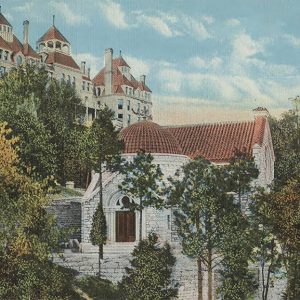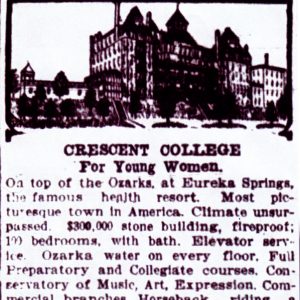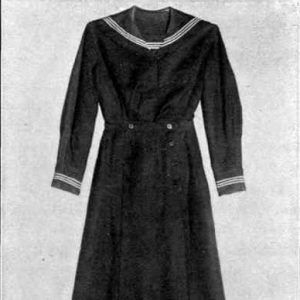calsfoundation@cals.org
Crescent College and Conservatory
The Crescent College and Conservatory for Young Women operated out of the Crescent Hotel in Eureka Springs (Carroll County). It was opened on September 23, 1908, and operated from September through June, with the summer months being devoted to hotel operations. The college remained open until 1924, when it was forced to close due to lack of funding. It reopened as Crescent Junior College in 1930 and remained open until 1934.
Founded by the Eureka Springs Investment Company, specifically A. S. Maddox and J. H. Phillips, Crescent College was established as an exclusive boarding school for young women. Maddox had previously operated a successful female seminary, known as Maddox Seminary, in Little Rock (Pulaski County) and was seeking a new location with better facilities. Eureka Springs offered seemed an excellent choice, and the school would help generate revenue for the Crescent Hotel, which had declined in the early twentieth century. Enrollment was restricted to eighty-eight students, who originally hailed from thirty-nine different states. Maddox served as the first president.
The college was known for its high standards and Christian atmosphere. Nine faculty members taught such subjects as math, science, languages, English, and history. Richard Ryan Thompson moved to Eureka Springs in 1908 to teach at the college and help with its operations. In 1910, he began his tenure as president, serving in this capacity until 1924. His wife, Mary Breckinridge Thompson, taught French and hygiene. Another staff member was Cecilia Paul, who was given the position of dean as well as hostess of the hotel in the summer months.
Over the years, the college expanded its course offerings to include music, speech, business, home economics, and art. The college also boasted a popular physical education program, which was mostly known for its basketball team. It also offered courses in tennis, hiking, and horseback riding.
According to the 1916–17 college catalog, girls were expected to bring several items with them to campus: “a counterpane (quilt), napkin ring, Bible, walking shoes, umbrella, raincoat, rubbers, laundry bag, and hot water bottle.” Their uniforms were “Peter Thompson” style, a mature and elegant version of a child’s sailor suit usually crafted from dark blue serge or linen, depending on the occasion, and worn with a scarf tied in a sailor’s knot. Students were required to wear a matching navy blue jacket during the winter months, as well as woolen underwear. They were to organize all purchases during the school year with the principal, and correspondence with the outside world was kept to a strict list provided by the parents at the start of the school year. Tuition for the year 1912 was $375.
The college also placed advertisements in popular magazines of the day. The following ad appeared in The Cosmopolitan: “Crescent College and Conservatory for Women. On top of the Ozarks. Famous for healthfulness and beauty of location. $300,000 fireproof building. Rooms with private bath. Elevator. Accredited Junior College. General courses; art, music, expression, domestic science.”
President Thompson worked for fourteen years to raise funds needed to continue operations of the college. In 1924, however, the college’s lease with the Crescent Hotel ran out, and without sufficient funding to purchase the property, Crescent College and Conservatory closed its doors. A January issue of the Flashlight cited a “lack of interest, lack of funds, and lack of backing by the citizens.” In 1930, with renewed interest from the community, the college reopened and was called Crescent Junior College, and A. Q. Burns served as president. The college had a girls’ basketball team called the Crescent Comets, as well as a prestigious faculty and staff. Crescent Junior College remained open until the end of the 1934 school year.
For additional information:
Grauley, Ernestine. “The Crescent Hotel—Its Majestic Halls House a Lot of History.” Arkansas Gazette, October 4, 1964, p. 4E.
John-Cole, Joada. “Crescent College and Conservatory of Music.” Carroll County Historical Quarterly 27 (Spring 1982): 1–10.
Woolery, D. R. The Grand Old Lady of the Ozarks. Hominy, OK: Eagle’s Nest Press, 1986.
Jenny Vego
Shiloh Museum of Ozark History

 Crescent College
Crescent College  Crescent College Ad
Crescent College Ad  Crescent College Uniform
Crescent College Uniform 



I just found my grandmother’s 1914 Crescent College yearbook – it is fascinating!